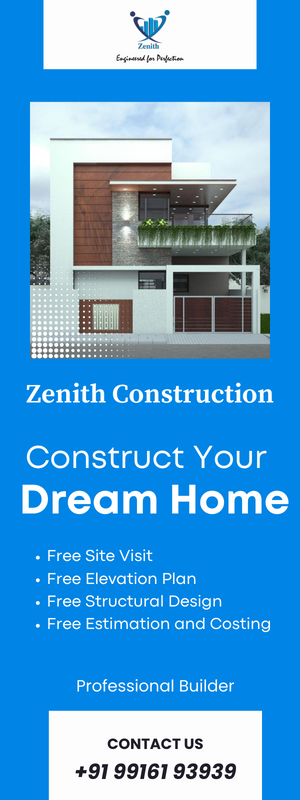
From G+1 to High-Rise: Navigating Floor Limit Rules in Mysore’s Urban Growth Story
As Mysore transitions from a heritage-rich tier-2 city to a modern real estate destination, developers and investors are beginning to re-evaluate one of the most critical aspects of project feasibility: floor limit regulations.
The number of floors you can build is not merely a technical constraint. It influences return on investment, architectural strategy, compliance timelines, and ultimately, the long-term sustainability of any residential or commercial project.
Understanding floor limit rules in Mysore, therefore, is not just about knowing how high you can build; it’s about understanding how strategically you can build.

The Regulatory Framework: What Governs Floor Limits in Mysore?
Urban development in Mysore is regulated by the Mysore Urban Development Authority (MUDA) and the local municipal corporations, all working under the guidelines of the Revised Master Plan (RMP) 2031.
This regulatory ecosystem establishes rules based on factors such as zoning, land use classification, road width, and the availability of infrastructure. Some of the key parameters that define floor limits include:
- Floor Area Ratio (FAR): FAR is the ratio between the total built-up area and the total land area. In simple terms, it determines how much construction you are allowed on a particular plot of land. Higher FAR values are permitted in commercial zones or along wider roads, while residential areas may have more conservative limits.
- Setbacks and Height Restrictions: The distance between the building and the plot boundaries—known as setbacks—directly impacts the number of floors you can construct. These setbacks vary based on the height of the structure and the width of the access road.
- High-Rise Development Protocols: Projects classified as high-rises (typically buildings above G+5 or G+6) are subject to additional safety, environmental, and infrastructure requirements. These include fire exits, water storage, power backup, and designated parking provisions.
- Zoning Classifications: The type of zone in which a plot lies determines the permissible types of development and the maximum number of floors allowed.
Why the Shift from G+1 to High-Rise is Gaining Momentum
Traditionally, Mysore has been known for low-rise constructions—mostly independent homes, bungalows, and G+1 or G+2 villas. However, this trend is undergoing a significant transformation, driven by macroeconomic and demographic factors.
Here’s why vertical growth is not just desirable but also inevitable:
- Land Cost Efficiency: As land prices rise steadily in Mysore’s key residential and commercial pockets, vertical construction allows better cost optimisation. A higher number of floors means more sellable or leasable units can be accommodated from the same plot size, thereby improving project profitability.
- Population Growth and Urban Influx: With congestion and saturation in Bangalore, many professionals and families are opting for Mysore due to its quieter lifestyle, improved air quality, and expanding infrastructure. This has increased the demand for both residential and commercial spaces.
- Improved Infrastructure: Enhanced road networks, upgraded water and sewage systems, and better electricity distribution have made it more viable to support high-density developments in certain zones.
- Policy Support: The Revised Master Plan encourages denser development in specific corridors, especially near major roads, bus depots, and tech parks, to prevent horizontal sprawl.
Why Floor Limits Are More Than Just a Compliance Issue
Many view building regulations as a box-ticking exercise. But in reality, floor limit rules impact nearly every aspect of a project’s success.
Here’s how:
- Capital Efficiency: A higher permitted FAR allows developers to construct more built-up space without acquiring additional land. This improves the internal rate of return (IRR) and overall asset yield.
- Project Design Strategy: Floor limits determine architectural planning, including the number of units per floor, parking availability, common areas, and amenities. A wrong estimation can lead to underutilised space or rework post-approval.
- Approval Timelines: Non-compliance with floor limits can result in delays, redesign costs, or even project stalling. A well-planned project that respects the regulatory framework enjoys a smoother approval process and faster go-to-market time.
- Market Absorption and Buyer Trust: Today’s buyers and investors are more aware of building codes and approval statuses. Projects that align with legal norms gain higher trust and better market absorption.
Understanding these nuances is crucial not just for builders but also for architects, urban planners, financial investors, and even property buyers who want long-term value and peace of mind.
How Zenith Construction Brings Strategic Value to Floor Planning
At Zenith Construction, we go beyond brick and mortar. Our approach integrates legal compliance, engineering excellence, and market intelligence to create projects that are not just buildable but bankable.
Here’s how we make a difference:
- Zonal Expertise: We conduct thorough land feasibility studies to ensure that proposed floor plans align with the local MUDA and BBMP norms, specific to the location.
- Customised Design Solutions: Whether it’s a G+1 residential villa or a multi-storey commercial complex, we tailor our designs to maximise space utility within legal constraints.
- Full-Spectrum Regulatory Support: Our in-house experts manage all documentation, including sanction drawings, compliance certificates, safety protocols, and environmental clearances.
- Future-Proofing Projects: Every project is designed not only to meet current standards but also to accommodate future infrastructure improvements, allowing for adaptive reuse and expansion wherever permissible.
- Reduced Risk Exposure: By integrating regulatory foresight into the initial design phase, we prevent downstream risks like design changes, penalty impositions, or FSI-related disputes.
We believe that regulatory awareness is not an afterthought—it is the foundation for responsible and scalable construction.
A Glimpse into Mysore’s Residential and Commercial Demand
The real estate demand landscape in Mysore is evolving in both residential and commercial segments.
Residential Trends:
- Mid-rise apartment complexes and villa communities are gaining traction among urban families and second-home buyers.
- Key micro-markets include Vijayanagar, Bogadi, Ring Road corridors, and Hebbal, where infrastructure is growing rapidly.
Commercial Demand:
- Office spaces, boutique commercial buildings, and co-working environments are rising, especially around Outer Ring Road and emerging tech parks.
- Businesses seeking cost-effective alternatives to Bangalore are finding Mysore a promising destination.
Both segments benefit immensely when developers proactively align their floor plans with government regulations, thereby reducing time to market and enhancing trust.
In Conclusion
Mysore is no longer a satellite city waiting to evolve. It is already a strategic transformation. But vertical growth must walk hand in hand with regulatory foresight.
Floor limit rules are not restrictions; they are tools for structured development. They protect livability, encourage sustainability, and ensure every stakeholder, developer, investor, and buyer participates in responsible urbanisation.
At Zenith Construction, we stand committed to helping you build higher, smarter, and within the boundaries of legality and long-term value.
Looking to Elevate Your Next Project with?
Let’s explore how your next residential or commercial development can be strategically aligned with Mysore’s evolving floor regulations.
📍 Visit: https://zenithconstruction.in
Starting @ 1899/-* Including GST
Get Your Appointment Booked Today.
Best Residential & Commercial contractors in Mysore
Experience unmatched expertise and craftsmanship with Zenith Construction, recognized as the Best Residential & Commercial Contractors in Mysore.



